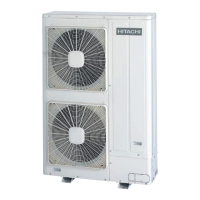W2: additional refrigerant charge per indoor unit
No of indoor units of 8 and 10 HP Amount of refrigerant per unit Additional refrigerant charge (kg)
x 1.0 kg/unit ______ kg
N O T E
It is not necessary to increase the additional refrigerant charge for indoor units with less than 8 HP.
W3: Additional refrigerant charge according to the connection capacity ratio of indoor units
Connection capacity ratio of indoor units = total capacity of indoor units / total capacity of outdoor unit
Ratio of indoor units Additional refrigerant charge (kg)
< 100% 0 kg
(100–115) % 0.5 kg
(116–130) % 1.0 kg
W: total additional refrigerant charge
Total additional refrigerant charge (kg) = W1 + W2 + W3
N O T E
Check that
the total additional refrigerant charge is not greater than the values given in: Maximum additional
refrigerant charge, see on page 60.
¿ Refrigerant charge
Once the installation has been emptied, check that the stop valves are fully closed; to do so, remove the caps and check
that they are closed with the corresponding torque:
• Heat pump system: Details of the gas and liquid stop valves, see on page 44.
• Heat recovery system: Details of the gas and liquid stop valves, see on page 52.
Charge the total additional refrigerant as calculated in chapter: Method of calculation of the total additional refrigerant
charge, see on page 60.
If it is not possible to charge the total quantity of additional refrigerant, proceed as follows:
Fully open the gas stop valve (in the case of the outdoor units of heat recovery systems, open the high and low pressure
gas valves).
Start the system running in cooling mode and open the liquid outlet valve of the measurement indicators connected to the
check joints of the stop valves.
Slightly open the liquid stop valve (tolerance of quantity of total additional refrigerant: 0.5 kg).
When all the refrigerant has been charged, fully open the liquid stop valve.
C A U T I O N
• Only charge
the quantity of additional refrigerant as calculated in chapter Method of calculation of the total
additional refrigerant charge, see on page 60. Too low or too high a charge could cause damage to the
compressor.
• The refrigerant should be charged through the liquid stop valve. If the refrigerant is charged through the gas
stop valves, the compressor will be damaged.
Fill in the F-Gas Label.
¿ Automatic system to estimate the amount of refrigerant charged in the unit
Fit all covers and lids on the unit, except for the electrical box and service covers.
3 Piping work and
refrigerant charge
61
SMGB0065 rev. 1 - 12/2010
3

